|
|
|
Sort Order |
|
|
|
Items / Page
|
|
|
|
|
|
|
| Srl | Item |
| 1 |
ID:
152288
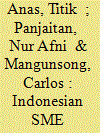

|
|
|
|
|
| Summary/Abstract |
This study examines the extent and nature of Indonesia’s SMEs’ participation in ASEAN economic integration based on a survey of 200 SMEs in the manufacturing sector. The survey shows that 79 per cent of respondents demonstrated awareness of the AEC. However, only 18 per cent of them were aware of the ASEAN Blueprint for SMEs. We found that 39 per cent of respondents think the AEC will increase domestic sales and the other 15 per cent believed it will decrease them. In terms of exports, 39 per cent of respondents expected their exports to increase in contrast to the 3 per cent who believed it they will decrease. Concerning their profits, 45 per cent of the respondents felt optimistic that their profits will increase, in contrast to the 13 per cent who felt they will decline. A large proportion of respondents were of the opinion that the AEC will affect them through: lower import duties (42 per cent of respondents); lower export tariffs (47 per cent of respondents); better custom procedures (42 per cent of respondents); better standard regulations (49.5 per cent of respondents); and improved recognition of professional qualifications (46 per cent of respondents). Our survey found a larger percentage of firms that did not utilize FTA forms (63 per cent) even though they were actively exporting, predominantly because of the lack of knowledge regarding their use. The Probit model showed a significant correlation between FTA use and export activities. There is also a significant positive relationship between FTA use and the probability of import. Furthermore, larger firms are more likely to utilize FTA forms.
|
|
|
|
|
|
|
|
|
|
|
|
|
|
|
|
| 2 |
ID:
152292


|
|
|
|
|
| Summary/Abstract |
This study aims to investigate the participation of Lao SMEs in regional economic integration. Supporting SMEs’ participation in regional economic integration is important to increase their productivity and competitiveness. However, there are various barriers that prevent this from occurring. In this study, a Logit model is applied to secondary data to investigate factors affecting exporting behaviour and preferential tariff utilization. This study finds that there are weak linkages between Lao firms and regional economic integration. Very few firms are exporting and the level of preferential tariff utilization is relatively low. Firms have a low level of awareness of economic integration and they appear to be too optimistic about its impact. It is important that policymakers should provide training on FTAs to export-oriented firms and potential exporters, together with a wider promotion of FTA utilization through media channels.
|
|
|
|
|
|
|
|
|
|
|
|
|
|
|
|
| 3 |
ID:
152286


|
|
|
|
|
| Summary/Abstract |
For decades, Myanmar’s economic system has been characterized by central planning and international isolation. Today, as the country undergoes a far-reaching political and economic transition, it is leaving this past behind. For Myanmar’s enterprises, and SMEs in particular, the opening of the country’s economy and the intensification of regional economic integration through the ASEAN Economic Community brings both opportunities and challenges. It is in this context that the present study investigates the extent of Myanmar SME participation in ASEAN and East Asian regional economic relations as well as the challenges they face and the policy support they need for deeper integration. More specifically, this paper addresses the following four questions: What is the state of Myanmar SMEs’ participation in regional trade, production networks, and investment activities? What are the enabling factors and obstacles to SME participation in regional economic activities? How are regional and preferential trade agreements affecting SMEs’ activities and performance? And what are the policy imperatives to promote active participation of Myanmar SMEs in regional economic integration? To find answers to these questions, this study not only analyses existing secondary data but also draws on a new dataset collected by the Centre for Economic and Social Development (CESD) through a survey among Myanmar enterprises which focuses on the food-processing and garment sectors. It is found that, at present, Myanmar SMEs hardly participate in regional economic activities. They face numerous challenges such as: constrained access to capital and skills; limited investment in technology, innovation and human capital; minimal usage of ICT; and low awareness of regional integration dynamics. To overcome these challenges and reap the benefits of regional economic integration, enhanced firm-level efforts are needed while the government can provide support on various fronts.
|
|
|
|
|
|
|
|
|
|
|
|
|
|
|
|
| 4 |
ID:
152289


|
|
|
|
|
| Summary/Abstract |
Small and medium enterprises are prevalent in Vietnam. They are also the predominant type of enterprise in the three manufacturing industries surveyed: food; apparel; and wood products. These have been the emerging export sectors in the last decade. The survey shows that SMEs in these sectors are highly aware of ASEAN’s plan for SME development and perceive that the ASEAN Economic Community is beneficial to business. However, the share of SMEs that have business relations with firms in other ASEAN economies is small. There is also limited awareness of Vietnam’s Free Trade Agreements. The regression analysis reveals that foreign ownership and productivity are the two most important determinants of Vietnam SMEs’ participation in production networks. Product innovation, process innovation and membership in business associations also significantly increase the probability that SMEs participate in production networks. The analysis suggests that policies to develop SMEs, increase labour productivity, and intensify international integration will facilitate SMEs’ participation in regional production networks. Government can also craft policies to promote innovation, encourage membership in industry and business associations, and raise awareness of ASEAN’s SME development plans, the AEC and other business related issues.
|
|
|
|
|
|
|
|
|
|
|
|
|
|
|
|
| 5 |
ID:
152287
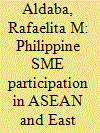

|
|
|
|
|
| Summary/Abstract |
This study aims to examine the extent and nature of Philippine SME participation in ASEAN economic integration. Based on a survey of 205 establishments, the results indicate that out of 205 firms, 41 per cent are FTA users, of which 48 (or 40 per cent) are SMEs while 33 (44 per cent) are large enterprises. The survey shows that although most firms are aware of the AEC (ASEAN Economic Community), they still have limited knowledge about the more specific impact of AEC on their business operations. About 62 per cent of SMEs are unaware of how the AEC would affect their business operations. Regarding the perceived effects of FTAs on SMEs, 53 per cent of the respondents indicated that they do not know, have no opinion or have no response. The major reason cited by firms for not using FTAs is they do not know how to use them. The regression analysis on the determinants of FTA use shows that the coefficients on firm size, age, exporting, foreign ownership, engaging in innovation, membership in industry association, and awareness of the AEC are all positive and significant. In terms of government support and assistance, the survey results indicate that only a small proportion of the respondent firms are being reached by existing government programmes. The results reaffirm the need for more substantial awareness programmes especially on how to use FTAs and how firms can take advantage of the opportunities arising from AEC integration and other FTAs.
|
|
|
|
|
|
|
|
|
|
|
|
|
|
|
|
| 6 |
ID:
152291
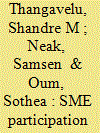

|
|
|
|
|
| Summary/Abstract |
This study employs survey data of 201 firms to explore the impact of trade policy on small and medium size enterprises (SMEs) in Cambodia. The results show that more than half of the surveyed firms were aware of the ASEAN Economic Community (AEC) and larger firms tend to use FTAs more frequently than SMEs. The key reasons identified in the study for not using the FTAs were mainly due to a lack of knowledge and also due to the complexity on the submissions of the required FTA forms. The strong import linkages with ASEAN and East Asia (as compared to export linkages) suggest that Cambodian firms take advantage of sourcing for cheaper intermediate inputs from ASEAN and East Asian economies and then export the final products to the U.S. and EU markets through generalized system of preferences (GSP) and Everything But Arms (EBA) arrangements. The results of the survey indicate that the perception that the AEC has or would decrease their domestic and export sales as well as their profitability, and face more competition in local and foreign markets. On the other hand, they think the AEC has or would decrease import costs and enhance accessibility to intermediate inputs. The impacts are believed to occur through the reduction of import and export tariffs/duties, increase in custom procedures, standards and regulations, recognition of professional qualifications, improved investment processes, and better connectivity. The empirical results indicate that compared to non-users, the active FTA users appear to be larger firms, have higher labour productivity, and have experience with multiple export markets. They are also members of business associations and have higher skill intensity and technological capability. Firm size, higher labour productivity, access to business networks, active use of information and communications technology (ICT), having more experiences with multiple export markets, skilled human capital and technological capability are important factors for firms to use multiple FTAs and participate in regional integration.
|
|
|
|
|
|
|
|
|
|
|
|
|
|
|
|
| 7 |
ID:
152285
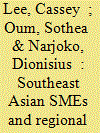

|
|
|
| 8 |
ID:
152290
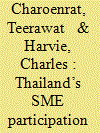

|
|
|
|
|
| Summary/Abstract |
Closer economic integration in ASEAN and East Asia presents many export opportunities for firms in economies such as Thailand. At the same time, it also presents them with many challenges. Small and medium-sized enterprises (SMEs) dominate the business landscape in Thailand but — like the country — are caught in a sort of middle-income trap. They face intense competition from SMEs in low labour cost, low value-add production locations in the region (such as Cambodia, China and Vietnam), yet they also are unable to transition into innovation, intensive higher value-adding activities (such as SMEs in Japan, Korea and Taiwan). Can Thai SMEs take advantage of the potential benefits arising from closer regional integration? This paper: assesses the role, contribution and significance of manufacturing SMEs to the Thai economy; examines the major challenges that they face and likely factors affecting their export participation; and identifies the policy framework environment in which they operate. An empirical analysis is then conducted identifying critical factors associated with Thai manufacturing SME exports. This uses Probit and Logit models based on data compiled for the 2015 ERIA-ISEAS Enterprise Survey of Thailand. Key results obtained suggest that foreign ownership of local enterprises, membership of an FTA, awareness of ASEAN and the ASEAN Economic Community and appropriately targeted government business support policies can most effectively increase the export participation of Thai small manufacturing firms.
|
|
|
|
|
|
|
|
|
|
|
|
|
|
|
|
|
|
|
|
|